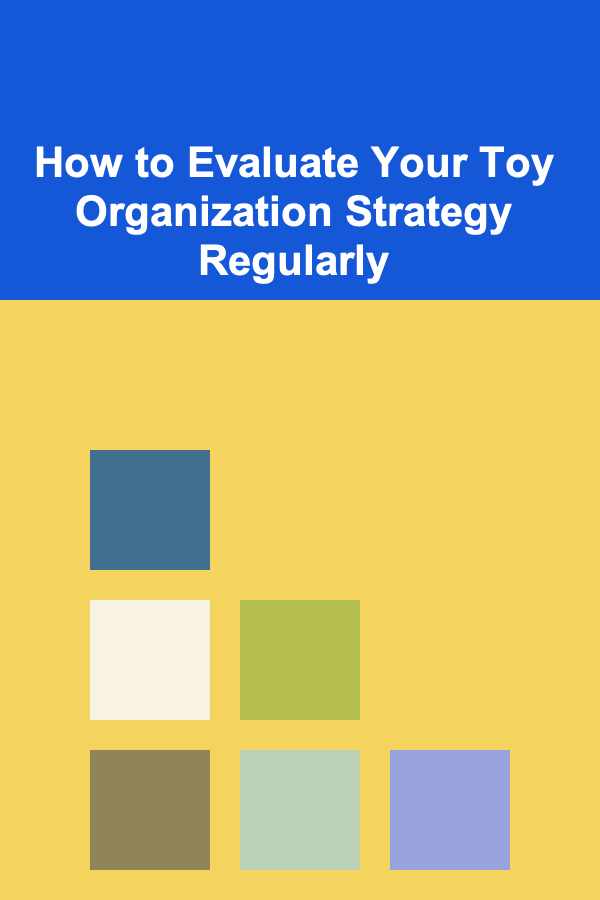
How To Create a Print-Rich Environment at Home
ebook include PDF & Audio bundle (Micro Guide)
$12.99$6.99
Limited Time Offer! Order within the next:

Creating a print-rich environment at home is a powerful way to promote literacy, learning, and intellectual growth. Whether you're a parent looking to enhance your child's reading and writing skills, or simply someone interested in enriching your own environment, a print-rich setting can have profound effects on cognitive development. This article explores the concept of a print-rich environment, why it matters, and practical steps to create one in your own home.
What is a Print-Rich Environment?
A print-rich environment refers to a setting that is filled with diverse forms of print materials. This can include books, posters, labels, written instructions, and other written forms of media. The primary purpose of such an environment is to expose individuals---especially children---to a wide variety of written language, helping them to develop reading and writing skills in natural, everyday contexts.
In essence, a print-rich environment encourages reading and writing to become an integrated part of daily life. The constant exposure to text in various forms allows individuals to engage with language in meaningful ways, fostering both academic and cognitive growth.
Why is a Print-Rich Environment Important?
A print-rich environment plays a critical role in the early stages of literacy development. The following are some of the key reasons why creating such an environment is important:
1. Encourages Literacy Development
For young children, the process of learning to read and write begins long before they enter school. When children are surrounded by text in their home environment, they begin to recognize letters, words, and symbols, which helps build a foundation for formal literacy education. By fostering an early love for print, children are more likely to develop strong literacy skills that will benefit them throughout their lives.
2. Supports Language Acquisition
A print-rich environment supports language development in both children and adults. When there is a lot of text to engage with, individuals can improve their vocabulary, grammar, and syntax by seeing words used in different contexts. For children, frequent exposure to written words helps them expand their language skills and improves their ability to communicate effectively.
3. Fosters Critical Thinking
In a print-rich environment, individuals are exposed to a variety of written materials, from books to articles to signage. This exposure encourages them to ask questions, make connections, and critically analyze information. The more people are exposed to printed words, the more likely they are to develop a critical approach to the material they read.
4. Enhances Reading Comprehension
A rich environment filled with written materials offers constant opportunities to engage with reading. This continuous exposure leads to better reading comprehension, as individuals develop strategies for decoding, understanding, and interpreting text. Additionally, when people are surrounded by reading material, they are more likely to become lifelong readers.
5. Encourages Independent Learning
When children and adults are provided with access to various forms of print, they are more likely to explore new topics, discover new ideas, and develop a sense of independence in their learning. A print-rich environment allows individuals to interact with texts in different ways---whether through reading for pleasure, researching a topic, or following written instructions.
Elements of a Print-Rich Environment
Creating a print-rich environment is not about filling a space with random pieces of paper or books. Instead, it's about being intentional in selecting the right materials and organizing them in a way that encourages interaction with print. Below are key elements to consider when building a print-rich environment in your home.
1. Books and Reading Materials
The cornerstone of a print-rich environment is, of course, books. A variety of books---across genres, reading levels, and topics---should be readily available. A well-stocked bookshelf or reading corner can ignite curiosity and provide endless opportunities for learning. Some important factors to consider include:
- Diverse Reading Materials: Choose books that are culturally diverse, covering a wide range of topics and ideas. This exposes children to different perspectives and encourages a love for learning.
- Age-Appropriate Books: Select books that match the developmental level of the readers in your home. For young children, picture books and early readers are key. For older children and adults, novels, non-fiction, and informational texts should be available.
- Interactive Books: Look for books that encourage engagement, such as books with pop-ups, flaps, or puzzles. These types of books can make reading more enjoyable and interactive, especially for younger readers.
2. Labels and Signs
Labeling is an excellent way to introduce print into the environment, especially for young children. Labels should be placed around the home to identify everyday objects and spaces, such as doors, windows, furniture, and appliances. Labels can be made with:
- Simple Words: Start with labeling common objects (e.g., "fridge," "window," "door") in easy-to-read fonts. As children become more proficient, you can add more complex labels.
- Bilingual Labels: If you speak more than one language, adding bilingual labels can help foster language acquisition and cultural awareness.
- Creative Typography: Use colorful, fun fonts for labels that are visually appealing, especially in children's rooms or play areas.
3. Posters and Wall Displays
Posters, charts, and wall displays are an easy way to surround people with text in their environment. These can serve as educational tools and visual aids. Consider including:
- Alphabet Posters: Large, visually engaging posters of the alphabet or numbers are great for young children, providing a visual reference as they learn the basic building blocks of language.
- Instructional Posters: Post informative charts, such as maps, multiplication tables, or grammar guides, in areas where people might frequently pass by. These materials reinforce learning and help with retention.
- Motivational Posters: Inspirational quotes or posters with affirmations can encourage positive thinking and emotional development.
4. Written Instructions and Recipes
Having written instructions or recipes visible in the kitchen, office, or other spaces adds to the print exposure in daily life. These are functional and can encourage reading and comprehension skills, while also offering opportunities to practice following written instructions.
- Cooking Recipes: Place recipes on the refrigerator or in the kitchen, where family members can read and follow them while cooking.
- Instructions for Household Tasks: Display instructions for tasks like sorting laundry, taking out the trash, or caring for plants. This is an excellent way to make everyday chores more interactive and informative.
5. Journals and Writing Spaces
Encouraging writing is another essential aspect of a print-rich environment. Providing journals, notebooks, and writing materials will motivate people to express their ideas and thoughts through writing. Here are some tips:
- Personal Journals: Encourage children and adults to keep a daily or weekly journal. Writing about their experiences, thoughts, and observations helps build writing skills and creativity.
- Storytelling and Writing Prompts: Use story starters or writing prompts to inspire creative writing. You can place these prompts on a bulletin board or keep them in a visible place.
- Writing Stations: Create a designated writing area with paper, pens, and other materials. This can be a corner of the home where family members can freely engage in writing activities.
6. Digital Print Resources
While traditional print materials are essential, the digital age has introduced new opportunities for creating a print-rich environment. Make use of the internet to expand access to written resources:
- E-books: Digital books are an excellent supplement to physical books, especially for older children and adults. Many e-book platforms offer a wide variety of reading materials across genres.
- Online Articles and Blogs: Encourage reading online articles, blogs, and educational resources. This expands the range of topics and ideas available for exploration.
- Educational Websites: There are many educational websites that offer interactive reading and writing games, activities, and resources for all ages.
Creating a Print-Rich Environment for Children
Creating a print-rich environment for children involves more than just surrounding them with books and labels. It's about making reading and writing a fun, engaging, and natural part of daily life. Here are some practical ways to foster literacy in children through print-rich environments:
- Daily Reading Routine: Establish a daily reading routine where children have dedicated time to read. This can be done at bedtime or during a designated quiet time in the day.
- Reading Aloud: Read aloud to children regularly, making the experience interactive by discussing the story, asking questions, and pointing out words.
- Provide Access to Books: Ensure that books are easily accessible and that children can choose books based on their interests. A dedicated reading nook can create a cozy space for them to enjoy books.
- Encourage Writing: Motivate children to write letters, notes, or even simple stories. You can make this more exciting by helping them create a family newsletter or journal.
Conclusion
Creating a print-rich environment at home is an effective way to promote literacy, language development, and independent learning. By surrounding yourself and your family with a variety of written materials---books, labels, posters, and more---you provide continuous opportunities to engage with print and enhance literacy skills. Whether you're introducing children to the world of reading and writing, or cultivating your own passion for learning, a print-rich environment is a valuable tool for intellectual and personal growth.
Reading More From Our Other Websites
- [Home Budget 101] How to Create a Budget for Home Renovations and Repairs
- [Home Maintenance 101] How to Prevent Pest Infestations with Regular Home Maintenance
- [Organization Tip 101] How to Organize Vintage Jewelry for Easy Sorting
- [Home Soundproofing 101] How to Soundproof a Bedroom Door for Maximum Privacy
- [Home Pet Care 101] How to Ensure Proper Pet Exercise and Mental Stimulation
- [Home Cleaning 101] How to Remove Mold and Mildew from Your Bathroom
- [Home Space Saving 101] How to Organize Your Small Appliance Storage for a Clutter-Free Kitchen
- [Home Soundproofing 101] How to Soundproof Hardwood Floors for Quiet Living
- [Whitewater Rafting Tip 101] Paddling Through Paradise: Top Wildlife Hotspots for River Rafters
- [Personal Care Tips 101] How to Apply Hair Gel for a Voluminous, Full Hair Effect

Creative Ways for Saving on Pet Expenses While Keeping Your Pet Happy
Read More
How to Communicate Effectively with Tenants
Read More
How to Create a Family Time Capsule for Milestones and Memories
Read More
How To Develop a Strong Personal Brand for Job Search
Read More
How to Evaluate Your Toy Organization Strategy Regularly
Read More
Monetizing Deep Learning through Cloud Services and APIs
Read MoreOther Products

Creative Ways for Saving on Pet Expenses While Keeping Your Pet Happy
Read More
How to Communicate Effectively with Tenants
Read More
How to Create a Family Time Capsule for Milestones and Memories
Read More
How To Develop a Strong Personal Brand for Job Search
Read More
How to Evaluate Your Toy Organization Strategy Regularly
Read More